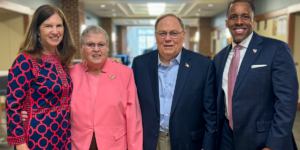In March, a unique collaboration between Shenandoah University’s (SU) physical therapy (PT) and dance programs introduced nine people with mobility impairments and their care partners to the benefits of dance. Led by Shenandoah Conservatory Associate Dean for Academic Success and Professor of Dance Ting-Yu Chen ’19, Ed.D and Adjunct Associate Professor of Dance Lisa Startsman, B.A., these new dancers moved their bodies to music under the watchful eyes of SU PT students and Associate Director of Clinical Education and Associate Professor in the Division of Physical Therapy Melissa Wolff-Burke, Ed.D., and SUPT adjunct faculty member Dr. Emily Hockman ’13 (Doctor of Physical Therapy). The participants in the pilot program had Parkinson’s Disease, strokes, brain injuries, and quadriplegia. These nine new dancers, their caregivers, and PT students and faculty as well as dance faculty participated fully and the responses to the pilot program were extremely positive.
“SU is a perfect place for this type of interprofessional and collaborative academic programming. Partnering with the medical community and people they serve provides mutual benefits to patient care, practical training for our students, and improving quality of life for people with mobility differences,” said Dr. Chen.
Participant Feedback
“The two days of dance were unlike anything being provided in this area and we both found the experience fun and beneficial. Adding music to exercise makes a huge difference in the activity!”
“Thank you for offering the adaptive dance class. We gently moved parts of our bodies that we never moved before!”
“The instructors were dedicated and made each of us smile while moving.”
“I think overall it would help to get us mobility challenged people to move in ways we’re not used to in a fun and lighthearted environment.”
Physical Therapy Student Feedback
“My ‘ah-ha’ moment from this experience was seeing what the freedom of dancing could do for [the participants], especially when they were hesitant at first to try dancing. Dancing brought out movement patterns that he did not seem to do much on his own…”
“Although it was a little out of my comfort zone, I enjoyed the adaptive dance sessions.”
The collaboration was a pilot program for what will hopefully become a regular event at SU combining the science of movement, dance and music for the benefit of those who, because of illness or injury, have lost mobility.
Caregiver Feedback
“SU benefits from [this program by adding], a very real interactive component to your dance and music and therapy programs. It puts SU’s name into the community which is a positive form of advertising!”




